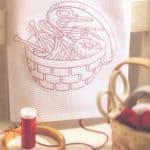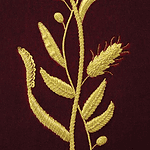A Brief History of Redwork
DEVELOPING RED THREAD
Europeans during the Renaissance knew that madder root could be used to dye textiles red, but the results were often an unsatisfactory shade of orange or coral. Only dyers in the Ottoman Empire and India seemed to possess the key to consistent red dyes.
In the eighteenth centuiy, French entrepreneurs finally unlocked the secret of vibrant Turkey Red. named for the Ottoman dyers who first introduced the color to Europe. Their discoveiy coupled with imports of cotton from British outposts in India, made inexpensive red cottonthreads and flosses available to those who couldn’t afford silk or woolen threads. Best of all, the new red dye produced thread that held its color even through harsh laundering.
By the mid-nineteenth century, red embroidery was everywhere. Common laundry marks, intended simply to distinguish one person’s linens from another’s, went from small white-on-white stitches to elaborately embellished monograms in fiery red. Table linens, dishtowels and handkerchiefs, subject to eveiyday use and rigorous laundering, now could be decorated with colored motifs. Cotton threads were less expensive than silk, so many more households could afford to embellish fabrics and clothing.
By the end of the nineteenth century, commercial dyeing and the development of synthetic dyes encompassed a wide spectrum of colors that could be reliably and consistently reproduced. Cotton was readily available around the world, and embroideiy floss in many colors became a sewing box staple.
THE POPULARITY OF REDWORK
The embroidery style we know as redwork reached the peak of its popularity during the nineteenth and early twentieth centuries. Only a few simple stitches are needed to create redwork embroideries, and their outline – only design style shortens the working time dramatically. Redwork is both simple enough for children and beginners and enjoyable enough for more advanced stitchers.
In the past, redwork designs printed on muslin and known as penny squares were available at general stores along with the floss and needles necessary for embroidery. Many children learned to stitch with these simple materials.
Women were also able to stamp their own designs at home, transferring patterns to parchment paper with a piercing tool and stamping powder. They were even encouraged to begin home – based businesses stamping redwork designs on fabric for sale.
Iron-on transfers developed in the 1870s were a great improvement over the cumbersome stamping technique. Magazines offered transfers as an incentive for subscribers, and catalogs offered patterns, fabrics, needles and threads for redwork.
REDWORK NOW
Today, redwork is a general term signifying outline only embroidery stitched primarily with a single color of cotton thread, using outline stitch (also called stem stitch) and a handful of other embroidery stitches. The designs can be stitched in any color and are sometimes given such names as bluework, greenwork or “redwork in purple.” The unifying characteristic of redwork embroidery is the pleasing contrast between the colored thread and the plain woven ground, usually muslin or other cotton fabric.
Redwork faded in popularity by the middle of the twentieth century, but it never disappeared completely. As years went by, redwork quilts and other linens became targets for antique hunters as buyers discovered the monochromatic designs’ continuing appeal. Now that the “retro” look is trendy, redwork motifs are back in the spotlight.
With the advent of computerized embroidery machines for the home, redwork embroidery has entered a new phase. By programming the motif in digitizing software, a stitcher can embellish almost any textile in a matter of minutes. Redwork designs have always been quick to stitch.
See also ideas for redwork
Don’t miss new embroidery design “Birds -ornament in the Russian style”










